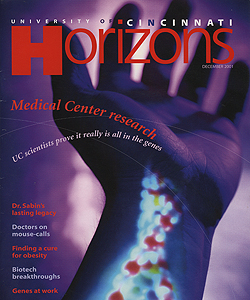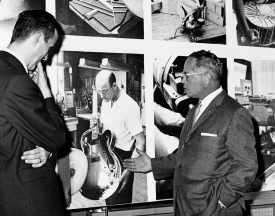by John Bach
When it comes to name dropping, no one could do it better than Theodore "Ted" McCarty, Eng '33. Chuck Berry, George Harrison and Jimi Hendrix are just a few. All three were musicians indebted to McCarty’s instrumental genius.
While other engineering grads were solving logistical challenges of American industry, building breathtaking bridges or erecting innovative buildings, McCarty was helping to mold the sounds of rock 'n' roll. His talent begat musical styles that have both inspired and incited generations of young people.
As president of the Gibson Guitar Co. during its golden period, he collaborated with renowned guitarist Les Paul in the early '50s to develop the solid-body guitar into the Les Paul model, arguably the most famous electric guitar in history. Though Ted never played it, his fingerprints are all over the instrument that transformed rock 'n' roll as well as country-Western music. McCarty died in April at the age of 91.
The innovative craftsman steered Gibson from 1948 to 1966. During his watch, Gibson's production ballooned from 5,000 instruments a year to more than 100,000. In turn, the number of employees at the Michigan-based firm leapt from 150 to 1,200 in 18 years.
"He was an engineer and an accountant, and he turned Gibson around," acclaimed guitar designer Paul Reed Smith told a reporter from McCarty's hometown paper in Twin Falls, Idaho. "It's fair to say that without him, our industry and the music would be different."
Different indeed.
The solid-body guitar, once a gimmick instrument, became a signature sound after McCarty, with Les Paul's endorsement and design assistance, crafted a beautiful mahogany and maple guitar capable of high amplification and noise-free operation. Later versions of the Gibson Les Paul powered the blues-rock sound of the late '60s and the Southern rock of the late '70s. Today, the Les Paul provides distinctive sounds for every genre of rock, from alternative to metal.

 Past Issues
Past Issues
